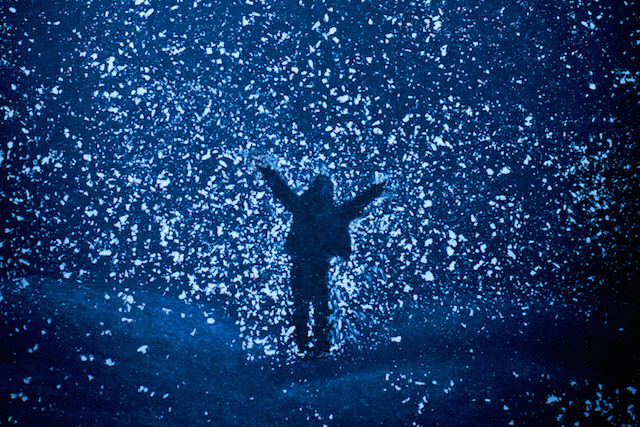
“There are plenty of obstacles in your path. Don’t allow yourself to become one of them.” ~Ralph Marston
I was sitting in a self-improvement course listening to the facilitator’s instructions. “I want you to come up with a Big, Hairy, Audacious Goal,” she announced. “This needs to be a stretch, something where you really put skin in the game. You have seven weeks to reach this goal.”
The rest of her instructions trailed off as I thought about which area of my life I wanted to improve. I overheard a few of my classmates talking to each other about their lofty physical goals. My body contracted when I heard them talking. I shrunk into my shame.
I couldn’t even run a 5k, I thought. I had lost my leg in a car accident thirty years previous and while there were many things I could do, running was not one of them. These days just walking was hard.
During our break, I found a place to be alone and take counsel with myself. I felt myself resisting the obvious goal. I sat down and shut my eyes. Can I do it? Can I walk a mile?
As I sat there, I thought about the first time I went backpacking after I lost my leg and how proud I was. I thought of the other physical adventures I’d had in my twenties: skiing, rock climbing, scuba diving, and skydiving.
But those experiences were so long ago. Not only had two pregnancies and aging changed my body, but I had just spent the past two years getting a new prosthetic leg made. Since I wasn’t able to walk much during the two-year fitting process, I had lost a lot of muscle and stamina; walking had become painful and difficult. I had walked out of my prosthetist’s office on my new state-of the-art leg just a month ago. Yes, I thought, it is time to regain my walking feet.
Back at the conference room, we each stood up in front of the group and pronounced our goal. They say, “When we compare we fall into despair” and that was certainly true for me when I heard other people declare their goals; I fell further and further into self-judgment.
Listen to her, she’s going to run a half-marathon. You’re just going to walk a mile. Big deal. You’re such a loser.
But a wiser voice inside of me spoke up, Wait a second. She has two legs; you only have one. Just focus on where you are right now.
When it was time for me to declare my goal, I went to the front of the room, took a deep breath, and said, “I am going to walk every day. I’ll start by walking down the street. Every day I’ll walk a little farther. My goal is to walk one mile.” I felt both excited and scared.
The next day I took my first walk. I walked down the block and back again. A burning ache filled my stump, forcing me stop and rest halfway through. The next day I walked two blocks and back.
Buoyed by my small success, I walked all the way around the block on the third day. The constrictive pain in my stump was intense and deep. With each consecutive walk, I learned how to deal with the pain, either by stopping to rest or by relaxing into it.
By the end of the third week I had achieved my goal: I had walked one mile! I continued to walk a mile a day for the rest of the course. At the end of the sixth week, I took a hike in the woods—four miles round trip. I was overjoyed, not only to walk so far, but to be back in the woods on a dirt path amidst the evergreen trees and the dappled sun.
After the course was finished, I wanted to keep walking but I knew I needed incentive and accountability. I also wanted my walking to mean something.
I found an organization that helps amputees in developing countries have access to prosthetic legs. That was it. I pitched my idea—a walking campaign to walk 100 miles in 100 days for 100 legs—and they loved it! A few weeks later I started my walking campaign. I walked a mile a day for one hundred days and raised $14,000, almost half of my goal.
After all these years of being an amputee, I still struggle with many of the same issues two-legged folks struggle with: motivation, attitude, gumption. When I remember to adopt these four attitudes and, believe me, I don’t always remember, then I find my life is much happier.
First, I’m curious about my inner dialogue.
Am I critical and judgmental, or am I my own best cheerleader? I’ve learned to chat with both my Inner Gremlin and my Inner Guide. They both have something to teach me. My Inner Gremlin talks first and then my Inner Guide chimes in. They sound something like this:
Inner Gremlin: It takes you twice as long as normal people to hike up this trail. You’re such a loser. You should just give up and go home. Who wants to hike with you when you’re so slow?
Inner Guide: Just because you’re slow doesn’t make you a loser. You are actually quite persistent and tenacious. Good for you!
Until I met my Inner Guide I can say, unequivocally, that my negative self-talk, my Inner Gremlin, was a far bigger limitation for me than my amputation.
Second, I focus on what I can do instead of what I can’t do.
When I was in college I had a lot of friends who excelled at physical activities. I had one friend who canoed the Arctic every other summer, another who was a white water rafting guide. Other friends climbed local mountains just for fun on the weekends. When I looked to them as mirrors for what I could be they were both inspiring and I felt defeated before I began.
No, I couldn’t heli-ski in fresh powder, but I did learn to ski on one leg. I couldn’t scale a mountain, but I discovered that I could backpack five miles.
I had to determine what I wanted from these experiences and then find ways to get that. I had to discover what value I received from these activities and find new, altered, or accommodated ways to get that value. If I can’t climb a mountain, how can I find adventure in another way?
Honoring my limitations taught me how to find the value in my activities.
Third, I try to be honest with myself.
When I was in my mid-twenties, I met a fifty-year-old amputee who had crutched to the top of Mt. Rainier. When I asked him how he did it, his recipe included a healthy dollop of weight lifting, a big cup of practice (which meant crutching around local parks with as many hills as possible), and a huge amount of grit.
I tried crutching around my neighborhood for a week and discovered something. For as badly as I wanted to be at the top of Mt. Rainier, for as much as I wanted to say I had climbed Mt. Rainier, I didn’t want to train to climb Mt. Rainier. I had to stare that reality in the face for what it was.
My limitation had nothing to do with my disability and everything to do with my mind. I didn’t want to put the time, energy and sweat into a training program that would get me to the top of the mountain. Once I saw this for what it was: a lack of desire for the whole package, I was okay with not climbing Mt. Rainier.
That doesn’t make me a loser. It makes me a woman who doesn’t like to sweat.
Fourth, I embrace the paradox.
I can accept and accommodate my limitations and still have moments of anger or sadness about them. I can feel motivated and be frustrated that it takes me so much effort to walk. We deny ourselves true access to our hearts when we deny our feelings.
It’s okay to feel frustrated, angry, or sad, but there’s always that extra step that leads us to the path of acceptance: choice. I have learned how to give my frustration, sadness, or anger a little time and then I move on.
We all have limitations. Even a rocket scientist probably isn’t going to make the best kindergarten teacher. Someone who’s tone-deaf will never be an opera singer. Whether our limitations are inflicted upon us from the outside or come from within, they force us to discover and embrace our strengths.
About Colleen Haggerty
Colleen Haggerty is a Forgiveness Coach, supporting people to find a way to accept their past and make the choice to walk into their future. Colleen shared her story of forgiveness through her TEDx talk and her memoir A Leg to Stand On, an Amputee’s Walk Into Motherhood.













 Though I run this site, it is not mine. It's ours. It's not about me. It's about us. Your stories and your wisdom are just as meaningful as mine.
Though I run this site, it is not mine. It's ours. It's not about me. It's about us. Your stories and your wisdom are just as meaningful as mine. 